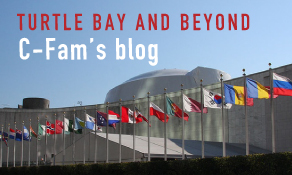What is the “unfinished business” of the ICPD?
INTRODUCTION
Twenty-five years ago, national leaders, UN representatives, and members of civil society met in Cairo, Egypt for the International Conference on Population and Development (ICPD). The resulting Programme of Action has influenced the agenda of the UN, particularly the work of the United Nations Population Fund (UNFPA), which was tasked with carrying it out. ICPD was a milestone in UN social policy: a coordinated attempt to create an international human right to abortion was blocked, and a compromise was achieved that remains in place, despite persistent controversy.
A quarter century later, national leaders are again preparing to convene, this time in Nairobi, Kenya, to revisit the ICPD agenda and discuss what “unfinished business” remains. For some, this means redoubling efforts to close the gaps in maternal and child health outcomes that remain, particularly in sub-Saharan Africa, despite progress in reducing preventable deaths since the early 1990s. For others, the “unfinished business” means finally achieving what was elusive both at Cairo and to the present day: establishing a human right to abortion and recognition of “sexual rights” in international human rights law, and seeing these concepts enshrined in national laws as well. This issue of Definitions explores the status of the ICPD at 25, with a particular focus on what has been characterized as its outstanding agenda, as it pertains to social issues such as abortion.
What was agreed at Cairo in 1994?
Writing in First Things in 1995, George Weigel characterized the plan for the ICPD as “The Great Cairo Turkey Shoot”—a predetermined outcome in which abortion on demand, “sexual rights,” and other sexual-revolution priorities would be delivered over the feeble protests of their opponents. This was not to be. Despite the best efforts of the U.S. government helmed by President Bill Clinton and the powerful pro-abortion lobby, as Weigel writes, “the most consequential thing that the planners of the Cairo conference had failed to take into account was the moral power of Pope John Paul II.”
The Pope was able to bring together a conservative coalition, referred to by its opponents as an “unholy alliance,” combining Catholics, non-Catholic Christians, Muslims, and others to block a right to abortion and weaken the anti-natalist language proposed by population control proponents. Additionally, the concept of “sexual rights” was rejected in the final document, producing the somewhat more unwieldy “sexual and reproductive health and reproductive rights.”
Critically, these terms were defined to create no new rights, such as a right to abortion. To the extent that these terms include abortion at all, it was with key caveats. Its legality was solely to be determined by the governments of member States, which were also urged to provide alternatives. It was meant to be provided “safely” to the extent that it was legal, which implies its inherent dangerousness. Abortion was also “under no circumstances” to be promoted as a method of family planning.
Other, less controversial, topics on which ICPD participants achieved consensus were universal access to education and the reduction of maternal and child mortality.
What constitutes a “Review Conference”?
In the years following ICPD, review conferences were held at five-year increments: ICPD+5, ICPD+10, and ICPD+15, all of which were adopted by the General Assembly after negotiations which reaffirmed the consensus reached at Cairo, without altering the compromises reached there on controversial issues. In 2010, the agenda, originally intended to span twenty years, was extended beyond 2014. However, UNFPA conducted the twenty-year review differently than previous iterations and conducted a series of regional review conferences, some of which included far more controversial language than the global-level reviews had adopted.
In November 2019, the Nairobi Summit will be held, described as “a high-level conference to mobilize the political will and financial commitments we urgently need to finally and fully implement the ICPD Programme of Action.” According to the official website, its central theme is “universal access to sexual and reproductive health and rights as a part of universal health coverage.” Already, this runs counter to international consensus: “sexual and reproductive health and rights” (SRHR) has been rejected at the global level repeatedly because it implies the existence of “sexual rights,” which were explicitly rejected in the original Cairo consensus.
This raises an important question: if the Nairobi Summit seeks to truly “finish the ICPD agenda by 2030,” what does this actually mean: fulfilling the promises made at Cairo, particularly to vulnerable mothers and children, or finally achieve the consensus on abortion and “sexual rights” sought by the organizers at Cairo, but blocked by lack of consensus at that time—and ever since?
Whose “unfinished agenda”?
Much has been written about the “unfinished agenda” of Cairo, beginning shortly after the conference concluded. In 1997, Marge Berer, who urged governments, in her journal Reproductive
Health
Matters, to create an international right to abortion, published an article about the “unfinished business” of abortion at the global level. She praised the Cairo outcome for acknowledging the adverse impact of “unsafe” abortion on women, “despite the extent of equivocation in the rest of the paragraph about abortion.”
As Emilie Filmer-Wilson and Luis Mora of UNFPA wrote, “progress…has not been linear for reproductive rights,” noting a lack of political support for the ICPD’s more contentious parts during its five- to fifteen-year reviews. “Yet,” they point out, “by the time of the twenty-year review of the ICPD in 2014, the political winds blew back again in support of the original vision of the ICPD.” Even so, in conducting their review, UNFPA took a novel approach: rather than attempt to achieve international consensus on a radically new set of standards, they conducted regional reviews and thematic meetings, producing a variety of outcome documents, not all of which were formally negotiated.
As one part of the twenty-year review process, UNFPA organized a conference with the UN’s Office of the High Commissioner for Human Rights and the government of the Netherlands in 2013. Its keynote speaker was Nafis Sadik, who led the Cairo conference as UNFPA’s executive director in 1994. In her speech, she discussed the ICPD’s “unfinished business.” She referenced the “minimal consensus position” that abortion should be safe where legal, then disregarded the agreed standard by saying, “the consensus does not address the rights of the woman who needs an abortion where it is not legal.” She also argued that “[sexual and reproductive health] programmes must move away from the maternal and child health delivery model.”
In addition to UN agencies, pro-abortion civil society organizations were also eager to lend support. “[A]s the twentieth anniversary of the ICPD loomed closer, SRHR activists and supportive governments began an analysis of the ‘unfinished business of Cairo’,” writes Françoise Girard, president of the International Women’s Health Coalition. Girard highlighted four key areas of concern, two of which were a right to abortion and recognition of “sexual rights.”
Among activists both within and outside the UN system, the impulse to move beyond the Cairo compromise is palpable. A 2016 article in the Bulletin of the World Health Organization concluded by stating, “Adolescents’ need for contraception and safe abortion and their right to plan pregnancies are still unfinished business for the 2030 Agenda for Sustainable Development.” The 2030 Agenda was adopted with reference to Cairo and no language suggesting a right to abortion, whether for adolescents or anyone else. Again, it is clear that “unfinished business” refers not to the aspects of an agreed agenda that may prove difficult; rather, it refers to those things that could never have been agreed in the first place.
What of the women and children?
The truly unfinished agenda of the ICPD—agreed at Cairo, reaffirmed by the UN General Assembly repeatedly in five-year review conferences, and further asserted through commitments made in the Millennium Development Goals (MDGs) and Sustainable Development Goals (SDGs)—is not politically contentious. It retains broad support.
Health care for mothers and children and access to education require sustained political and financial commitment by governments, but they need not be controversial. Furthermore, the reduction of preventable maternal and child deaths were the two goals farthest behind their targets at the conclusion of the MDG era. Despite tangible progress, recent estimates indicate that the SDG targets for reducing maternal and child mortality numbers will fall short unless the pace of improvement accelerates.
UNFPA typically releases its flagship annual report: “State of World Population” in late fall. In 2019, in anticipation of the Nairobi Summit, they released it early in the year, under the all-too-familiar title “Unfinished Business.” While avoiding an explicit call for legal abortion to be a human right, the document includes “expanded access to safe abortion care” among its selection of “policy measures to address newborn or maternal mortality” and calls on partner groups to “draw attention to the sexual and reproductive health services that do not feature in the SDG targets and indicators, given the risk that these will rank low in government policy and investment choices.” The report also acknowledges that “[a]s was the case with the ICPD and the MDGs, however, the SDGs do not acknowledge sexual rights,” while pointing out that some regional groups and civil society organizations have called for their recognition. By using the phrasing of SRHR throughout the report, a term which implies the existence of “sexual rights,” UNFPA clearly signals its view.
UNFPA staff have made clear their desire to move beyond the words of ICPD, and shake off the conservative viewpoints of donor and recipient nations that slowed its progress at Cairo and have worked to contain it in the decades since then. Unfortunately, UN agencies such as UNFPA, whose mandate includes maternal and child health, remain committed to promoting a controversial agenda for which consensus does not exist. Thanks to the efforts of Pope John Paul II and his coalition of conservative leaders and civil society groups, the text of the ICPD outcome was far better than its organizers had hoped. But as long as its implementation remains in the hands of UNFPA and its allies, who remain committed to the “spirit” of the ICPD, above and beyond its text, women and children will remain the truly “unfinished” part of its “unfinished business.”
See PDF for full citations.
View online at: https://c-fam.org/definitions/what-is-the-unfinished-business-of-the-icpd/
© 2025 C-Fam (Center for Family & Human Rights).
Permission granted for unlimited use. Credit required.
www.c-fam.org









